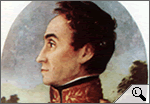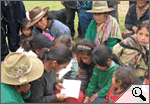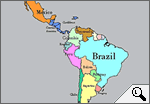|
|
|
 |
 |
 > Bolívar and San Martín, heroes of the fight for independence > From the Criollos to the Indigenous Peoples > Challenges facing Latin America dimarts, 28 de setembre de 2010
2010 marks the two-hundredth anniversary of the beginning of Latin America's march for independence, a process which put an end to more than three-hundred years of Spanish control, first imposed in 1492.
The wars of independence brought with them the creation of a number of countries, among them Bolivia, Ecuador, Venezuela, Argentina, Colombia, Mexico, Chile, Uruguay, Paraguay, El Salvador and Peru. Some of these countries have already held their bicentenary celebrations (Mexico and Chile, for example, held their celebrations this September), and others are soon to do so. Nearly all of them have set up commemorative websites, with information regarding the schedule of activities. Once the war had been lost, the Spanish empire saw itself significantly reduced in size. Only Cuba and Puerto Rico were left (as well as the Philippine archipelago in Southeast Asia), but these three territories were also lost in 1898.
Bolívar and San Martín, heroes of the fight for independenceIn 1808, Napoleon's troops invaded Spain, sparking the so called Spanish war of independence (known in the Catalan Countries as the Frenchman's war), which lasted until 1814. It was within this context that the Latin American colonies uprising took place, bringing to fame such names as Simón Bolívar and José de San Martín.
From the Criollos to the Indigenous PeoplesThe independence movement was lead above all by the Criollo people; descendents of Spaniards born in the Americas who came to form a socially and economically powerful class. In the new Latin American countries the power rested firstly with the Criollos, and secondly with the Mestizos (those born of one white and one indigenous parent), but not with the indigenous peoples, not with those who inhabited the land before the Spanish colonisation.
Challenges facing Latin AmericaThe indigenous populations of Latin America are still fighting for recognition of their social, territorial and linguistic rights. In fact, this recognition is one of the great challenges facing Latin America. Another is the reduction of social inequality; there are huge differences between the rich and the poor, and the middle class is not as extensive as the middle class in Europe, for example.
|
Investiga

> Figures principals de la lluita per la independència de l'Amèrica Llatina.

> Origen dels noms dels països de l'Amèrica Llatina.

> Sobre la colonització espanyola de les Amèriques (1492-1898).
I també...
- 1898: fi definitiva de l'imperi espanyol i consolidació del catalanisme.
- Espanya: bicentenari sense assumpció de culpes.
- Bolívia: el bicentenari de la independència i els indígenes.
Portada |
Europa Press |
El Punt |
La premsa |
Especials |
Diari de l'escola |
LesFinances.info |
Editorials |
Mail obert |
Els blocs |
Lletres
Tecnologia i ciència | Solidaritat | Cap de 7mana | Campus | El 9 | Presència | Fòrums | Enquestes | Xat | Correu
Traductor | Edicions en Pdf | Wap-pda | Biblioteca | Lletra més grossa
Tecnologia i ciència | Solidaritat | Cap de 7mana | Campus | El 9 | Presència | Fòrums | Enquestes | Xat | Correu
Traductor | Edicions en Pdf | Wap-pda | Biblioteca | Lletra més grossa
| Què és VilaWeb? Publicitat Mapa web Contacte | Una web de Partal, Maresma i Associats, S.L. |





